
September 11-18 live war map: Russia shifts offensive from Pokrovsk to south, Ukraine tears up Russian border
For the first time this year, the number of battles in the Kurakhove sector has surpassed those in the Pokrovsk sector, signaling a shift in Russian focus as they consolidate efforts on both fronts. Meanwhile, Russia is making advances near Chasiv Yar and Kupyansk but is facing unexpected crises in the Kursk region
Kursk front in Russia
Throughout the week, Russian forces launched a series of counteroffensives in the Kursk region, four of which targeted the areas of Borki, Zhuravli, Pogrebki, and Snagost. The Ukrainian Armed Forces successfully repelled some of these attacks.
On the eastern section of the front, Russian troops managed to continue the offensive and, after driving Ukrainian troops out of the village of Ulanok, entered Borki, where fierce fighting is currently taking place. Further north, they also started fighting for Biryukovka, where Russian conscripts were previously surrounded. Counterattacks continue on the northern flank: The Ukrainian Armed Forces are storming Volokonsk and Aleksandrovka, through which they intend to cut the Korenevo-Rylsk road.
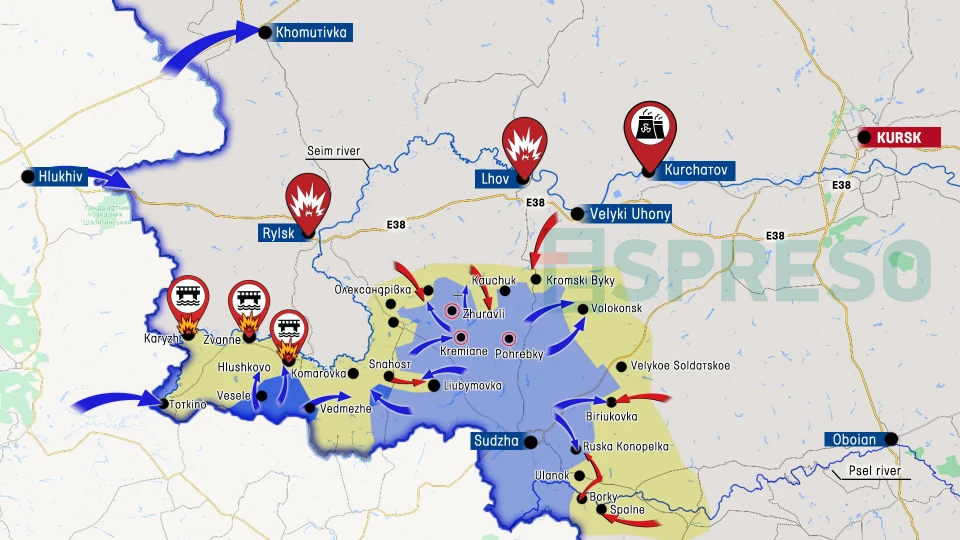
Meanwhile, Russian troops are attacking in the direction of Olgovka, Zhuravli and Sheptukhovka to unblock their other surrounded units. Near Olgovka, the Ukrainian Defense Forces retreated a bit, but at the same time destroyed one of the blocked Russian groups and continued to block another near Kremianoye. The attack on Pogrebki stalled.
However, Russia concentrated most of its efforts on removing the threat of isolating the Glushkovsky district. To do this, Russian troops launched a series of attacks from the west and north in the direction of Snagost. After several days of fighting, the Ukrainian Armed Forces retreated to Lyubimovka and Obukhovka, unable to withstand the onslaught. The Russian armed forces pursued the Ukrainian troops, but they were defeated by Ukrainian paratroopers who came to help. At the same time, the 225th Assault Battalion of the Ukrainian Armed Forces broke through the border defense near the village of Veseloye and in a few days broke through to the southern outskirts of the district center of Glushkovo, expanding the offensive to the east and west. This forced Russian troops to stop their attacks, as they had completely forgotten about protecting their rear. Fighting is still going on in Snagost itself, but Russian forces are now thinking more about how to get about 8,000 soldiers out of the encirclement and defend Glushkovo and Korenevo. Meanwhile, Ukrainian defenders have occupied a part of the border village of Tetkino, where a powerful Russian contingent is still on the defensive.
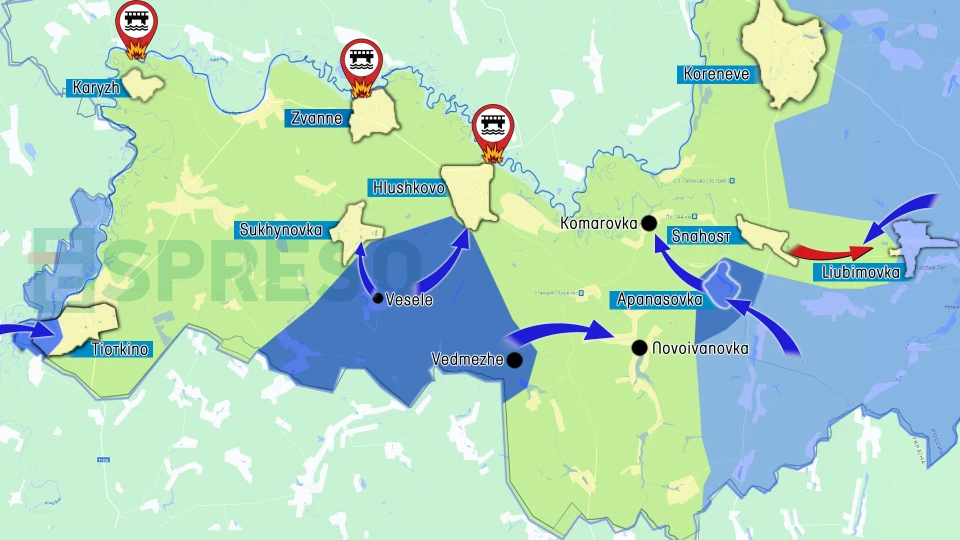
However, these are not all the surprises the Ukrainian Armed Forces have prepared. A heat map of strikes from NASA shows that over the past few days, the Ukrainian military has intensified strikes on the border with Bryansk region, near the villages of Seredyna-Buda, Znob-Novhorodske and Semenivka. This may indicate that new raids are being prepared or have already taken place in Russia. In addition, a border breakthrough was recorded near the village of Khomutovka, but its consequences are currently unknown.
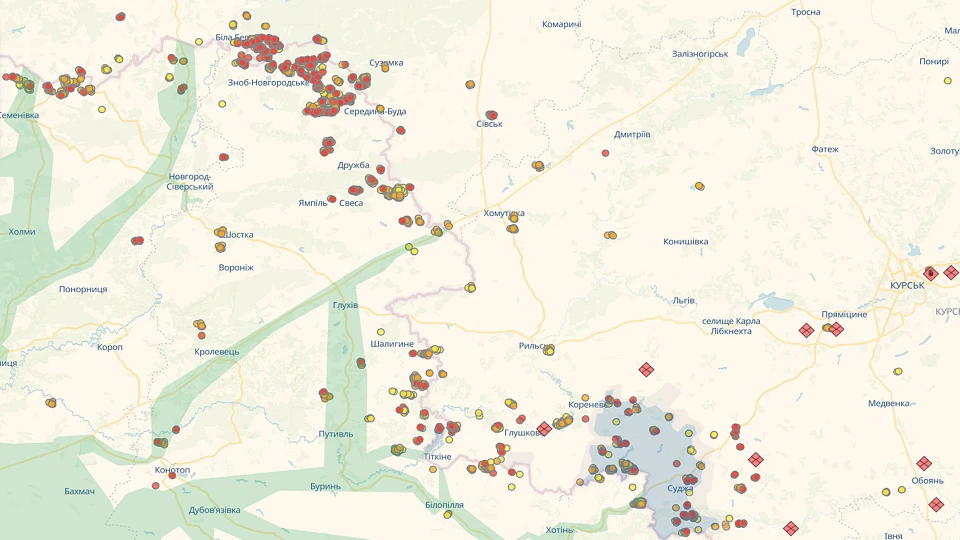
In the city of Toropets, Tver region, more than 100 Ukrainian drones hit the largest ammunition depot of the Russian Main Missile and Artillery Directorate in the entire war - 30,000 tons of ammunition exploded, and the fire area covered 6 km in width. In the short term, this will affect the fighting, especially in the Kursk and Kharkiv regions.
Luhansk and Kharkiv regions
Russian troops continued to expand their zone of control west of Pishchane and simultaneously advance to the Oskil River. The first villages on the left bank of the Oskil, Kolisnykivka and Kruhliakivka, are just over 3 kilometers away. If this pace of advance continues, by October Russian troops forces will be able to reach Oskil and cut this section of the frontline in eastern Kharkiv region in half, severing the connection on the left bank of the river between Kupyansk and Borova. However, the situation here is not critical at the moment, as both cities are able to provide logistics from the other side, via bridges or pontoon crossings. To the north of Kupyansk, Russian troops occupied a part of Synkivka, which has been under battle for over a year. Fighting is still ongoing in the southern part of the village.
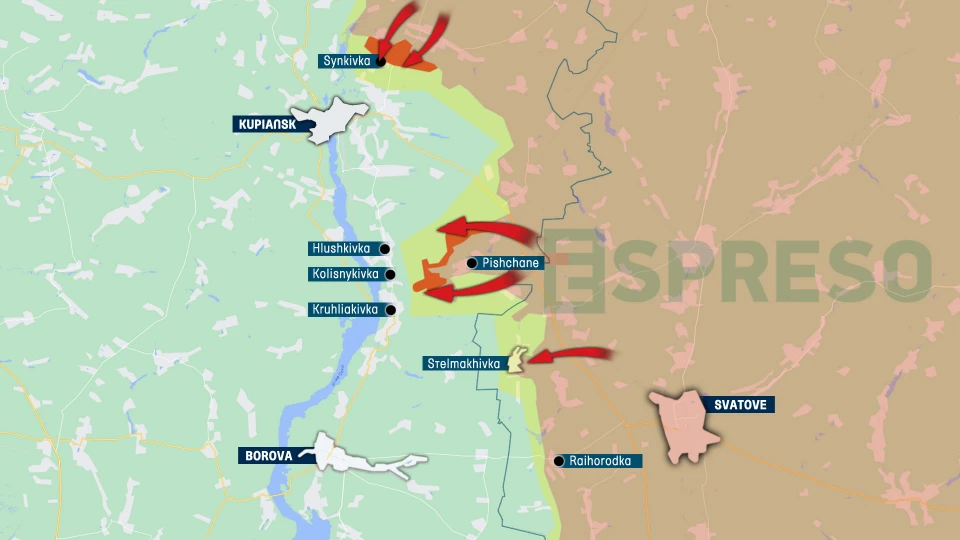
On the frontline between Lyman and Borova, Russian forces completely occupied the village of Makiivka, but were unable to cross the Zherebets River. Further south, they significantly expanded their zone of control near the village of Nevske, approaching the outskirts of the village by less than 1 km. In contrast, the Ukrainian Defense Forces pushed back their enemy in a 4km stretch near Torske.
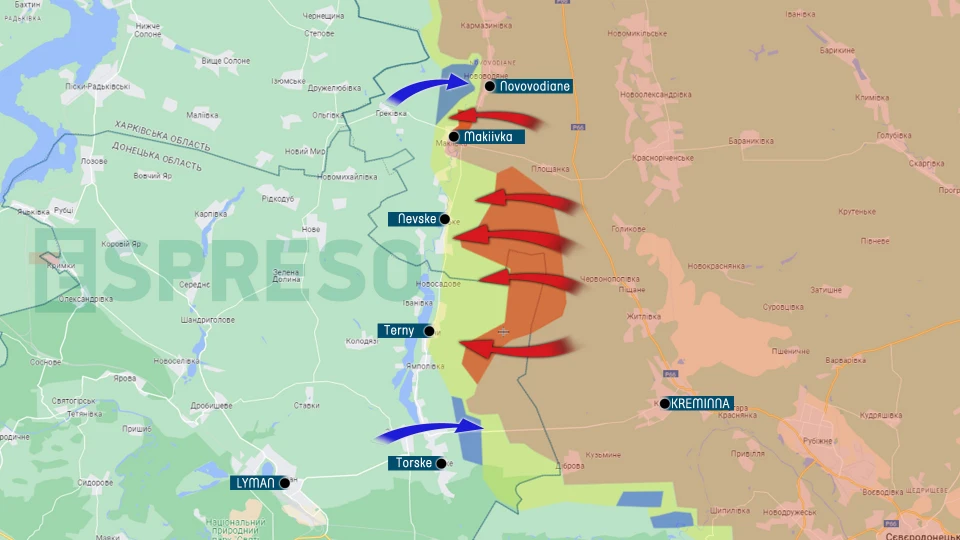
Chasiv Yar and Siversk
There have been no significant changes in this section of the frontline for a long time. The Ukrainian Armed Forces repelled all Russian attempts to cross the Chasiv Yar canal and break through Ukraine's defense head-on. The Ukrainian Defense Forces also cleared out Russian units that had crossed the canal south of Chasiv Yar, near Kurdiumivka. However, the expansion of the control zone near Klishchiivka and Ivanivske looks quite threatening, because if the Ukrainian Defense Forces are knocked out of this dominant hill, Russian troops will have significantly improved conditions for an offensive on Chasiv Yar from the south.
So far, Russian troops have managed to cross the water barrier in the village of Kalynivka from the north and are trying to expand the area captured on the right bank of the canal. The Ukrainian Armed Forces are counterattacking to eliminate this breakthrough.
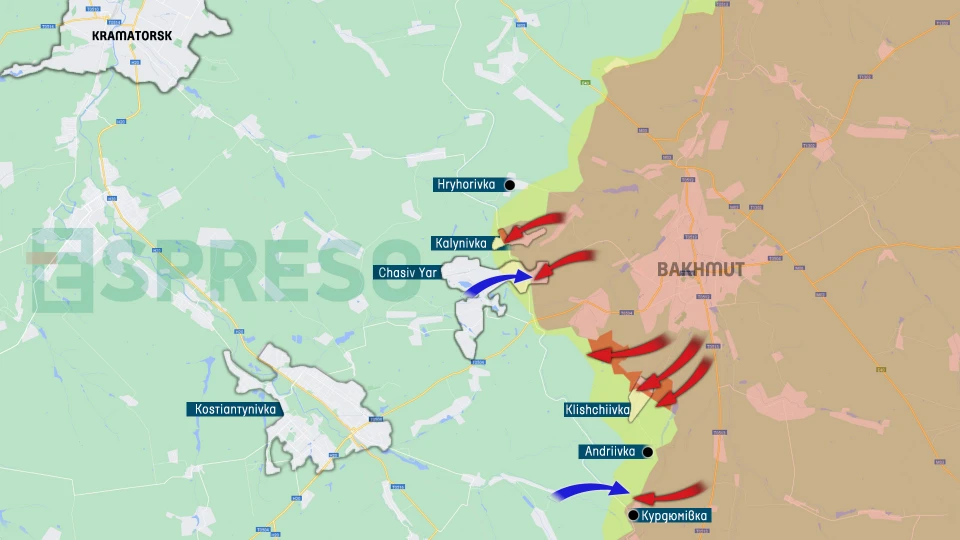
Another threatening occupation was the loss of the village of Spirne, 10 kilometers from Siversk. However, there will be no rapid Russian advance in this area.
Pokrovsk front holds the line, but Kurakhove is under threat
As Russia shifted the main focus of their assaults to the south, its successes in the northern part of the Pokrovsk front were minimal. In particular, Russian troops occupied several more streets in Hrodivka and managed to cross to the other side of the Zhuravka River in the town. Hrodivka was virtually completely occupied.
In the area of Novohrodivka, Russian forces expanded their control to the west of the town to the outskirts of Lysivka and to the north, occupying a spoil tip near Krutyi Yar. In addition, Russia destroyed two overpasses between Pokrovsk and Myrnohrad.
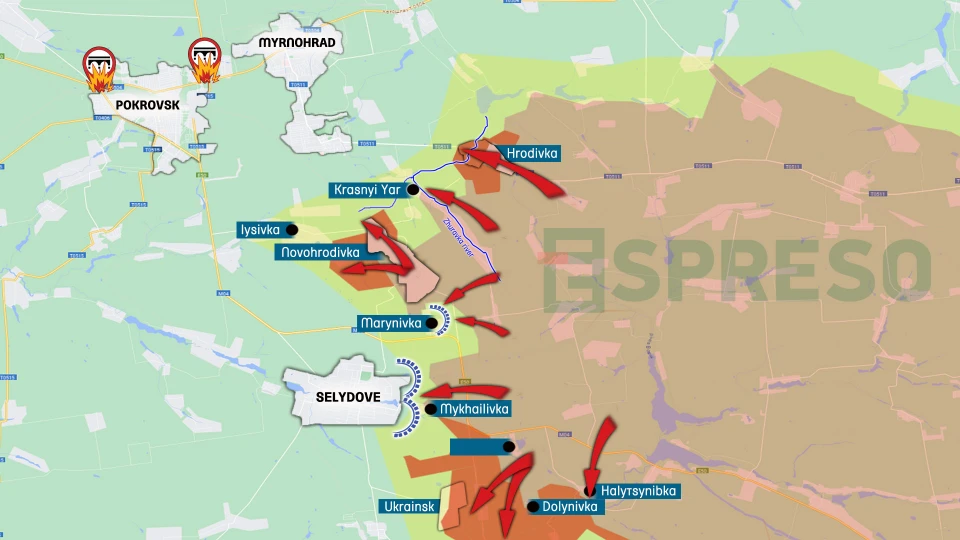
Despite the semi-circumvention, the Ukrainian Armed Forces still retain partial control over Marynivka and have managed to prevent a breakthrough to Selydove. However, the Russian army is trying to surround the city rather than storm it head-on, and therefore made a maneuver to break through from Memryk to the area between Selydove and Ukrainske. This breakthrough could allow them to bypass Selydove to attack it from three sides. Selydove is now the main obstacle to Russia's advance to Pokrovsk from the southern flank.
Fierce urban combat continues in Ukrainsk, where the Ukrainian Armed Forces currently control approximately 10% of the western territory near the spoil tip and the mine. However, due to intense pressure from Russian forces, the Ukrainian Defense Forces are expected to fully withdraw from the city soon.
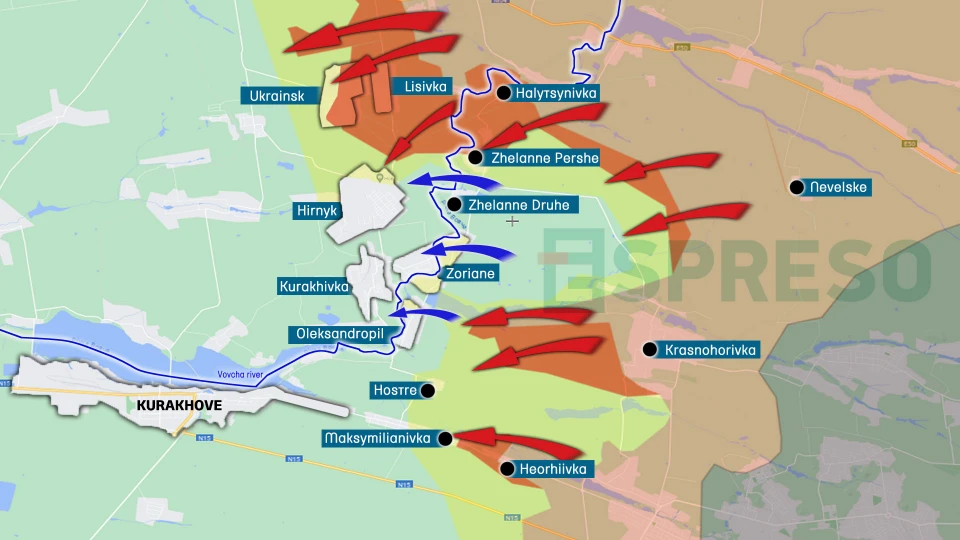
They have now approached the northern outskirts of another town, Hirnyk, which should be able to stop the invading Russian troops for a long time. It is the defense of Hirnyk that determines whether the Ukrainian Armed Forces will be able to retreat from the Nevelske pocket in time. Russian troops are putting pressure on this pocket both from the north, where they occupied Halytsynivka and Zhelanne Pershe, and from the south, where they are attacking the remains of unoccupied Krasnohorivka. From Krasnohorivka, Russian troops are pushing in two directions: along the Lozova River to Oleksandropil and Hostre, and are also trying to force the river in the northern direction, where the Ukrainian Armed Forces are engaged in rearguard battles. The Ukrainian defense forces have instead taken up defensive positions in Zhelanne Druzhne and are gradually retreating to the Zhuravka crossing in Zoriane. In the best case, this process is likely to take several weeks. At worst, they will have to fight their way out of the encirclement.
To a large extent, this scenario depends on how long the Ukrainian Armed Forces will be able to hold the line in the villages of Hostre and Oleksandropol. So far this week, Russian troops have overcome 5 kilometers and started fighting for Hostre, which is one of the key villages in the defense of Kurakhove. At the same time, the Russian Armed Forces ended the occupation of Heorhiivka and began to storm Maksymilianivka, the last village before Kurakhove. In order to launch an offensive on this town, they will need to break through more than 7 kilometers of Ukrainian defense. In fact, we can talk about the unification of the Pokrovsk and Kurakhove fronts, as the situation in one will directly affect the other.
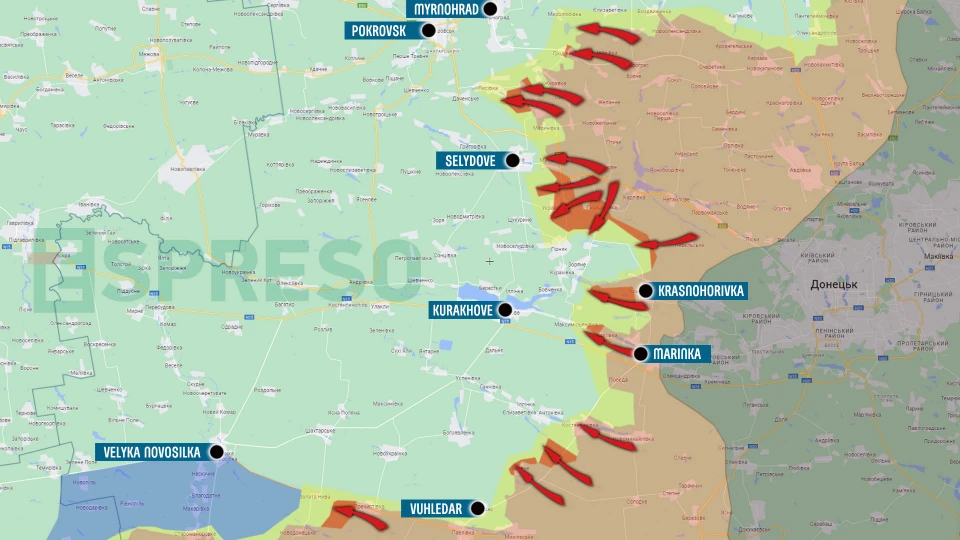
Surrounding Vuhledar
The situation around the city is becoming more and more threatening. The Russian Armed Forces moved a significant part of their reserves here and attacked more than 280 times in different areas during the week, an absolute record for this section of the frontline.
After the occupation of Vodiane, Russian troops began to storm Pivdenodonbaska mines No. 1 and No. 3. Retreating from mine No. 3, the Ukrainian Armed Forces blew up a 115-meter-high mine shaft to deprive Russian forces of an advantage. However, the invading Russian troops advanced in the direction of the main logistics artery from Kurakhove through Bohoyavlenka to a distance of 4 km. The battle for mine No. 1 and the spoil tip near it is still ongoing.
Meanwhile, Russian forces approached the southern outskirts of Katerynivka across the field, which will make it easier for them to complete the occupation of Kostiantynivka.
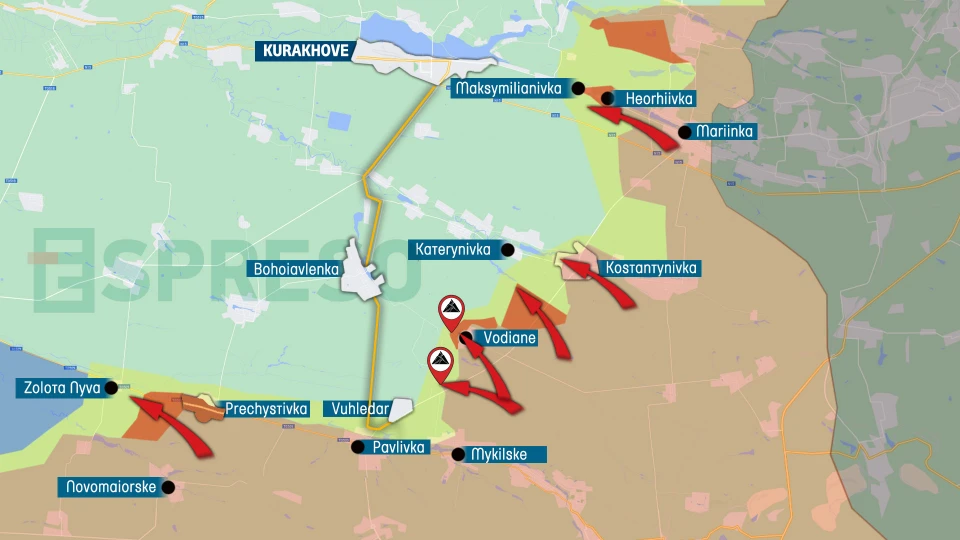
To the southwest of Vuhledar, they have advanced a few kilometers in the direction of Zolota Nyva. On this section of the front, they are looking for ways to force the Kashlahach River to get behind the defenders of Vuhledar. It seems that it is on the Vuhledar direction that Russian troops want to achieve the fastest possible result and capture the Vuhledar “fortress”. If this happens, it will have negative consequences for the entire southern front, not only in Donetsk but also in Zaporizhzhia region.
The maps were created using data from the General Staff of Ukraine’s Armed Forces and other verified sources. However, they are approximate and primarily reflect trends in the war zone.
- News











































